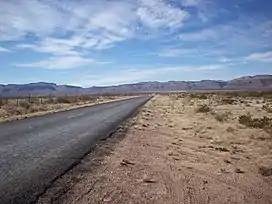Sierra Vieja
The Sierra Vieja is a small mountain range in the Trans-Pecos region of West Texas, 42 miles northwest of the city of Marfa in far western Jeff Davis County and northwestern Presidio County. The range extends 16 miles south, from just east of the Van Horn Mountains.[1] Locally known as the Candelaria Rim Rock, the Sierra Vieja comprise the southernmost tip of the Southern Rocky Mountains in North America.[2] Sierra Vieja is Spanish for "old mountains."
| Sierra Vieja | |
|---|---|
 South and North | |
| Highest point | |
| Peak | Capote Peak |
| Elevation | 6,212 ft (1,893 m) |
| Coordinates | 30°17′N 104°33′W |
| Dimensions | |
| Length | 16 mi (26 km) |
| Geography | |
| Country | United States |
| State | Texas |
| Geology | |
| Type of rock | Igneous |
Capote Peak is the most prominent in the range and is located fourteen miles northwest of Ranch to Market Road 2810. It has an elevation of 6,212 feet above sea level, with its summit rising 1,882 feet above nearby Capote Creek.[3] The peak stands at the southeastern edge of the range. Capote means "cloak" or "cape" referring to the fog and mist that occasionally surrounds the peak.[3] Local folklore recounts that the name may be related to the Lipan Apache Chief Capote, who lived in the region around 1850.[2]
Cultural history
Archaeological evidence indicates a long history of human presence in the Sierra Vieja. When Cabeza de Vaca, the first European to explore the Big Bend in 1535, traveled up the Rio Grande, the explorer encountered a large Native American population.[2] The extensive number of Indian sites along Walker Creek and Capote Creek are also evidence of human occupation for thousands of years.[2] In later years, the Apache resided in the Sierra Vieja. The Native American presence in the area hindered cattle ranching until the final years of the nineteenth century.[2] The Sierra Vieja rim has long served as an unofficial boundary, with Spanish language and culture prevailing west of the range on both sides of the Rio Grande. The range largely remains within the boundaries of several large ranches.
Geology and vegetation
Large-scale silicic volcanism began in the Sierra Vieja about 39 million years ago and continued until about 35 million years ago, with the range being composed of a sequence of tertiary flow and pyroclastic rocks.[4] The shallow, stony soils in the Sierra Vieja support live oak, piñon pine, juniper, conifer, cacti, and grasses.[1] The mountains are also home to the Hinckley columbine, a variety of Aquilegia chrysantha.[5] The plant has fern-like, delicate foliage and canary yellow flowers. It grows to three and a half feet tall and is endemic to a single site: Capote Falls in the Sierra Vieja.[5] Capote Falls, located on spring-fed Capote Creek, is the highest waterfall in Texas at 175 feet. Despite its location in one of the driest parts of the state, it is the main drainage below the Rio Grande Rift and the Sierra Vieja on its way to the Rio Grande, and as such it consistently flows.[6] The waterfall is located on private property.
References
- "Sierra Vieja". Texas State Historical Association, Handbook of Texas. Retrieved 2015-04-18.
- Justice, Glenn (2004). "Valley Beneath The Sierra Vieja: A Texas Border Ranch History". Circle DUG Ranch. Rimrock Press. Retrieved 2015-04-18.
- "Capote Peak". Texas State Historical Association, Handbook of Texas. Retrieved 2015-04-18.
- Urbanczyk, Kevin; Rohr, David; White, John. "Geologic History of West Texas" (PDF). Texas Water Development Board. Department of Earth and Physical Sciences, Sul Ross State University. Retrieved 2015-04-18.
- "Native Plant Database". Lady Bird Johnson Wildflower Center. Retrieved 2015-04-18.
- "Capote Falls". Texas Outside. Retrieved 2015-04-18.